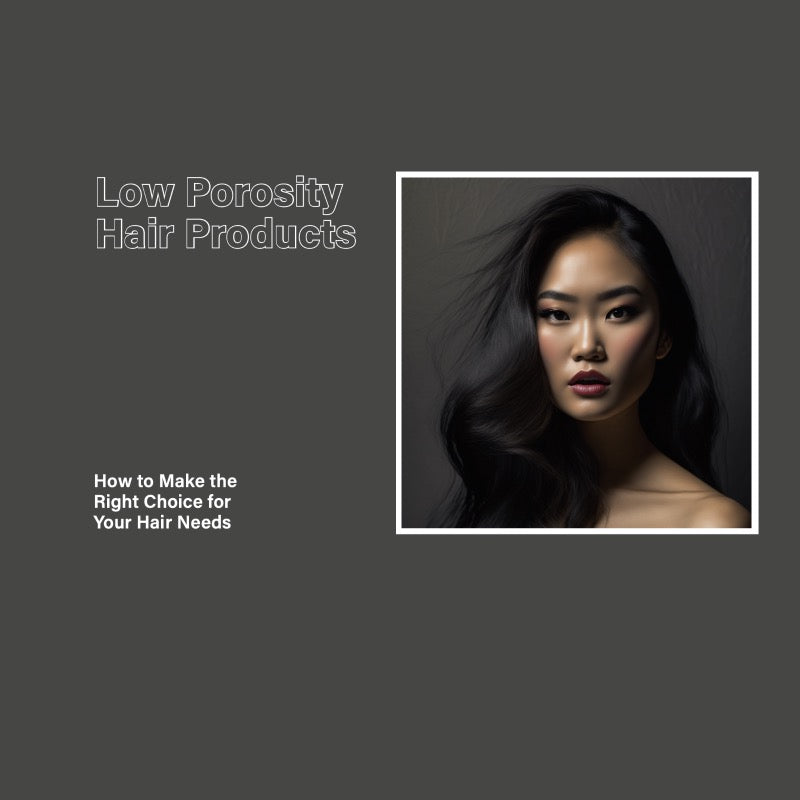Navigating the world of hair products can be overwhelming, especially when dealing with low porosity hair. With the proper guidance, however, you can make informed decisions and choose the best products to nourish and care for your unique hair type.
In this article, we'll explore the ins and outs of low-porosity hair products and how you can make the right choices for your hair needs.
Understanding Low Porosity Hair
Before diving into product recommendations, it's essential to understand what low-porosity hair is and how it behaves. Low porosity hair has tightly sealed cuticles, making it difficult for moisture and products to penetrate the hair shaft. This can result in dryness, frizz, and difficulty retaining moisture.
Key Characteristics to Look for in Low Porosity Hair Products
Now that you have a basic understanding of low porosity hair let's explore the essential characteristics to look for in hair products tailored for this hair type.
Lightweight Formulas
Low porosity hair is prone to product build-up due to the closed cuticle structure. To avoid weighing down your hair and causing build-up, opt for lightweight formulas that won't sit on top of the hair shaft.
Penetrating Ingredients
Since low porosity hair struggles with moisture absorption, look for products containing ingredients known to penetrate the hair shaft, such as coconut oil, argan oil, and rice amino acids.
Humectants
Humectants attract moisture from the environment and draw it into the hair shaft. Look for products containing humectants like glycerin and honey to help maintain the moisture balance in your low porosity hair.
Protein-Free or Low Protein Formulas
Low porosity hair tends to be protein-sensitive, meaning it can become stiff and brittle with excessive protein treatments. Opt for protein-free or standard protein formulas to avoid overloading your hair with protein and causing potential damage.
Protein-Free or Low Protein Formulas
Low porosity hair tends to be protein-sensitive, meaning it can become stiff and brittle with excessive protein treatments. Opt for protein-free or low protein formulas to avoid overloading your hair with protein and causing potential damage.
Step-by-Step Guide to Choosing and Using Low Porosity Hair Products
Now that you know the characteristics to look for in low porosity hair products, let's walk through a step-by-step guide to choosing and using them effectively.
Step 1: Determine Your Hair's Porosity Level
Before selecting any products, it's crucial to confirm that you have low porosity hair. You can do this by performing a simple water test. Place a clean strand of hair in a glass of water. If the hair floats, you have low porosity hair. If it sinks, your hair is likely high porosity.
Step 2: Choose the Right Shampoo
Opt for a clarifying shampoo to remove product build-up and open the hair cuticles, allowing for better moisture absorption. Look for shampoos with gentle surfactants and avoid those with harsh sulfates, as they can strip your hair of natural oils.
Step 3: Select a Suitable Conditioner
A well-formulated conditioner for low porosity hair should be lightweight, hydrating, and protein-free. Make sure to choose a conditioner that contains penetrating ingredients and humectants to maximize moisture retention.
Step 4: Incorporate a Leave-In Conditioner
A leave-in conditioner is a game-changer for low porosity hair, as it helps to maintain moisture throughout the day. One fantastic option is Coco Creme, a leave-in conditioner designed to moisturize, detangle, and protect your hair from damage. Its creamy and thick texture makes it perfect for all hair types. Coco Creme offers multiple benefits, including improved manageability, protection from damage, and added shine. In addition, key ingredients like rice amino acids ensure your hair remains smooth, manageable, and protected.
Step 5: Opt for Lightweight Styling Products
When styling low porosity hair, lightweight products are your best friends. Choose styling creams, gels, or mousses that won't weigh down your hair or cause build-up. Also, remember to avoid products with heavy silicones, as they can further seal the hair cuticle and prevent moisture absorption.
Step 6: Use Heat to Enhance Product Penetration
One helpful trick for low porosity hair is using heat to open the hair cuticles and enhance product penetration. When deep conditioning, use a heated cap or warm towel to help the product better penetrate your hair. You can also use a hair steamer to help your hair absorb moisture more effectively.
Step 7: Develop a Consistent Hair Care Routine
Maintaining a consistent hair care routine is crucial for managing low porosity hair. Ensure you're regularly clarifying, conditioning, and moisturizing your hair to keep it healthy and hydrated.
Additional Tips for Low Porosity Hair
To further support your journey with low porosity hair products, here are some additional tips:
- Experiment with the LOC (Liquid, Oil, Cream) or LCO (Liquid, Cream, Oil) methods to find the best layering technique for your hair type. This can help you effectively lock in moisture.
- Use a microfiber towel or t-shirt to dry your hair instead of a traditional towel, as this can minimize frizz and damage.
- Avoid over-manipulation and excessive heat styling, as these can lead to breakage and damage.
- Practice regular trims to keep your hair healthy and free of split ends.
By understanding the unique needs of low porosity hair and choosing the right products, you can keep your hair healthy, hydrated, and looking its best.
Remember to check out Nature Elixir's extensive range of hair care products, including the Coco Creme Leave-In Conditioner, to find the perfect solutions for your hair needs.
With the proper care and attention, you'll be well on your way to achieving the gorgeous, healthy hair you've always dreamed of.
Frequently Asked Questions (FAQ)
Q: What products are good for low porosity hair?
A: Good products for low porosity hair include clarifying shampoos, lightweight and protein-free conditioners, and hydrating leave-in conditioners like Coco Creme. In addition, opt for light styling products that won't weigh down your hair or cause build-up.
Q: How can I moisturize low porosity hair?
A: To moisturize low porosity hair, use hydrating hair products containing humectants, penetrating ingredients, and lightweight oils. Incorporate a leave-in conditioner, like Coco Creme, into your routine to maintain moisture throughout the day. Experiment with the LOC or LCO method to lock in moisture. Consider using heat, like a heated cap or hair steamer, to enhance product penetration.
Q: What should low porosity hair avoid?
A: Low porosity hair should avoid heavy silicones, sulfates, and excessive protein in hair products, as these can contribute to build-up and make it difficult for moisture to penetrate the hair cuticle. Additionally, minimize the use of heat styling tools and over-manipulation, which can lead to breakage and damage.
Q: What product ingredients are best for low porosity hair?
A: The best product ingredients for low porosity hair include humectants (e.g., glycerin, aloe vera, and honey), lightweight oils (e.g., grapeseed oil, argan oil, and jojoba oil), and penetrating ingredients (e.g., coconut oil, rice amino acids). These ingredients help attract and retain moisture while allowing the hair to absorb and maintain hydration effectively.

